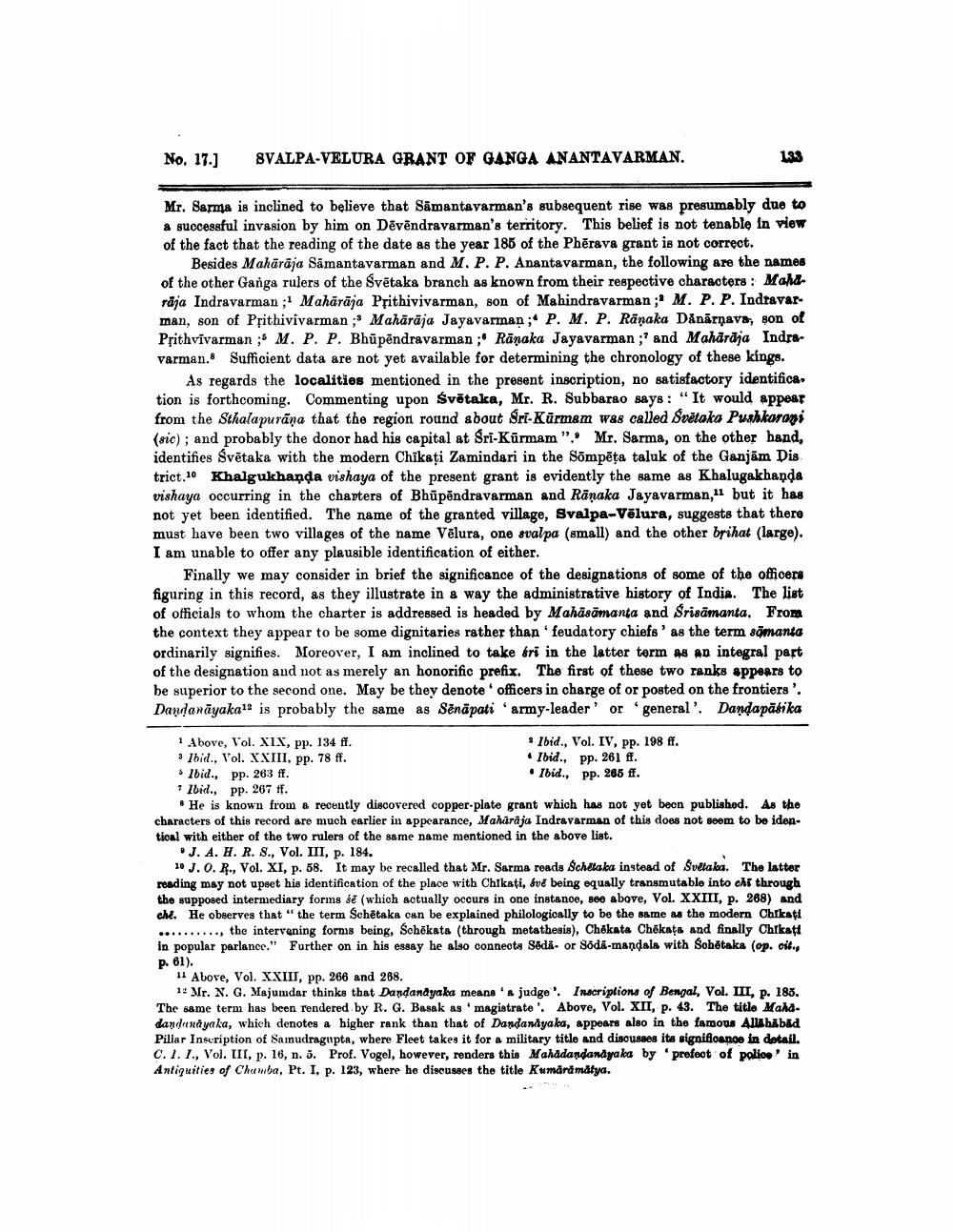________________
No. 17.)
SVALPA-VELURA GRANT OF GANGA ANANTAVARMAN.
Mr. Sarma is inclined to believe that Samantavarman's subsequent rise was presumably due to a successful invasion by him on Dēvēndravarman's territory. This belief is not tenable in view of the fact that the reading of the date as the year 186 of the Phērava grant is not correct.
Besides Mahārāja Samantavarman and M. P. P. Anantavarman, the following are the names of the other Ganga rulers of the Svētaka branch as known from their respective characters: Mandraja Indravarman;' Mahārāja Prithivivarman, son of Mahindravarman ;' M. P. P. Indravarman, son of Prithivivarman ;Mahārāja Jayavarman;" P. M. P. Ränaka Dånārņava, son of Přithvīvarman ;5 M. P. P. Bhūpēndravarman ;* Rāņaka Jayavarman ;' and Maharaja IndraVarman. Sufficient data are not yet available for determining the chronology of these kings.
As regards the localities mentioned in the present inscription, no satisfactory identifica. tion is forthcoming. Commenting upon śvētaka, Mr. R. Subbarao says: “It would appear from the Sthalapurāņa that the region round about Sri-Kūrmam was called Svētaka Pushkarani (sic); and probably the donor had his capital at Sri-Kūrmam". Mr. Sarma, on the other hand, identifies Svētaka with the modern Chikati Zamindari in the Sompēța taluk of the Ganjam Dis. trict 10 Khalgukhanda vishaya of the present grant is evidently the same as Khalugakhanda vishaya occurring in the charters of Bhūpēndravarman and Rāņaka Jayavarman, but it has not yet been identified. The name of the granted village, Svalpa-Vēlura, suggests that there must have been two villages of the name Vēlura, one svalpa (small) and the other brihat (Large). I am unable to offer any plausible identification of either.
Finally we may consider in brief the significance of the designations of some of the officers figuring in this record, as they illustrate in a way the administrative history of India. The list of officials to whom the charter is addressed is headed by Mahäsämanta and Srisämanta. From the context they appear to be some dignitaries rather than feudatory chiefs' as the term sömanta ordinarily signifies. Moreover, I am inclined to take sri in the latter term 48 40 integral part of the designation and not as merely an honorific prefix. The first of these two ranks appears to be superior to the second one. May be they denote officers in charge of or posted on the frontiers '. Dandanāyakal' is probably the same as Sēnāpati 'army-leader' or general'. Dandapātika
1 Above, Vol. XIX, pp. 134 ff.
Ibid., Vol. IV, pp. 198 ff. 3 Ibid., Vol. XXIII, pp. 78 ff.
• Ibid., pp. 261 ff. Ibid., pp. 263 ff.
• Ibid., pp. 265 ff. 7 Ibid., pp. 267 If.
. He is known from a recently discovered copper-plate grant which has not yet been published. As the characters of this record are much earlier in appearance, Maharaja Indravarman of this does not seem to be iden. tioal with either of the two rulers of the same name mentioned in the above list.
J. A. H. R. S., Vol. III, p. 184. 10 J. 0. R., Vol. XI, p. 58. It may be recalled that Mr. Sarma roads Schilaka instead of Svetaka. The latter reading may not upset his identification of the place with Chikati, kve being equally transmutable into che through the supposed intermediary forms &č (which actually occurs in one instanoe, 800 above, Vol. XXIII, p. 268) and che. He observes that "the term Schętaka can be explained philologically to be the same as the modern Chrkati .........., the intervening forme being, Schökats (through metathesis), Chokata Chökats and finally Chrkati in popular parlance." Further on in his essay he also connects Sodā. or Södā-mandala with Sohotaka (op. cit., p. 61).
11 Above, Vol. XXIII, pp. 266 and 288.
1: Mr. N. G. Majumdar thinks that Dandandyala means '& judge'. Inscriptions of Bengal, Vol. III, p. 188. The same term has been rendered by R. G. Basak as 'magistrate'. Above, Vol. XII, p. 43. The title Mahadandanayaka, which denotes a higher rank than that of Dandandiyaka, appears also in the famous Allahabad Pillar Inscription of Sainudragupta, where Fleet takes it for a military title and discusses its significance in detail. C. 1. 1., Vol. III, p. 16, n. . Prof. Vogel, however, renders this Mahadandanayaka by profect of polioe' in Antiquities of Chumba, Pt. I, p. 123, where he discusses the title Kumard matya.




